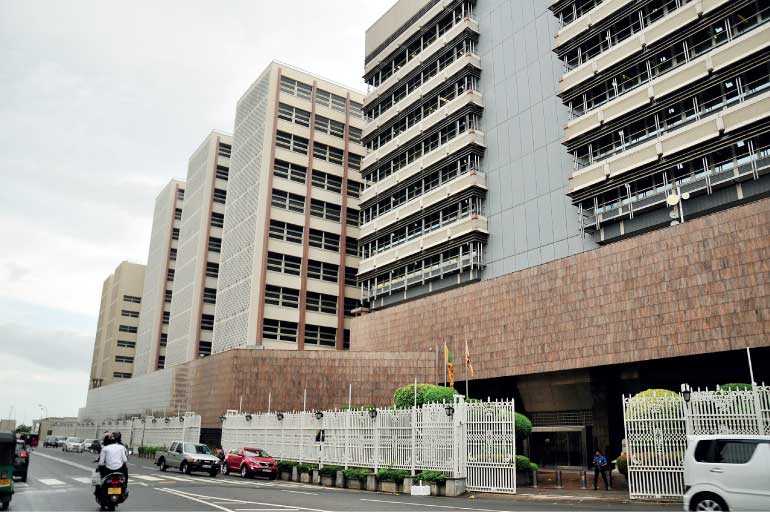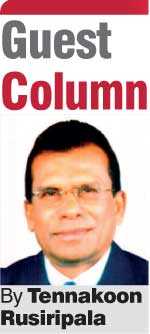Monday Apr 28, 2025
Monday Apr 28, 2025
Monday, 13 August 2018 01:01 - - {{hitsCtrl.values.hits}}

In a previous article, I discussed about the contemplated policy changes of the EPF system. One of the main concerns was the proposal to entrust the management of the investment portfolio of the fund to a specially appointed fund management company. The underlying argument is the need to invest the EPF balances more profitably, with a view to generate additional income for the beneficiaries. Indeed a creditable and admirable motive, if the rationalisation is bona-fide.
The EPF is the largest fund in the country, having a balance to its credit close upon Rs. 2000 billion. Approximately about 95% of the fund remains as investments in Government stock, which is considered as the safest form of investment. The Fund is authorised to bid for Treasury Bonds like any other primary dealer competing with them, and is hence ensured the opportunity of taking the advantage of the best prevailing market conditions and rates. Approximately amounts not exceeding 5% of the Fund balance are allowed to be invested in stock market operations. As was highlighted in the previous article, these operations and the results have not been successful, and fallen short of expectations.
Besides, there have been instances of highly questionable investment deals tainted with fraud and corruption in the EPF. The Fund has been the final borrow of shady operations perpetrated towards the alleged embezzlement of funds. The surmise regarding the proposed investment plans has arisen in this context. It is therefore necessary to examine the nostrum of the elixir by the policy makers, and the surrounding facts behind certain other changes in the administration and controls recently effected. Regarding the latter, we observe that the ETF and the EPF administrations have been distanced from the Treasury, under the policy changes effected by the Yahapalanaya Government. When the CBSL was removed from the purview of the Finance Ministry, the EPF too, which was under the operational control of the CBSL, moved out of the purview of the Finance Ministry. The administrative control of the ETF too was subject to a ministerial change. There have been many corrupt and unethical happenings in the aftermath of these unconventional changes. Some remain undisclosed, due to high-level influencing, while many have come out and are well-known in the public domain now. When such things are happening under the purview of public officers responsible and statutorily accountable, the extent of possible misdoings and corrupt deals that could transpire under a private fund management body is unimaginable. In a country where the appointed Governor of the Central Bank has run away after a fraudulent operation involving public funds, and remains as a fugitive, can we expect sacramental operations by imported fund managers?
The proposers of the move are citing examples of success stories where fund managers are performing wonders in this field. The focus, as announced by the policy makers, is to allow the external fund managers /private fund managers, with their international best practices, to use the EPF for better returns. While it is not correct to disregard these views, we are of the opinion that at the same time it is imprudent to ignore the wisdom of some nasty experiences elsewhere in this regard. An often cited case in favour of the proposal is the Temasek Wealth Fund of Singapore, and the Central Provident Fund investments in Temasek. I wish to indicate certain relevant facts relating to Temasek and its operations, as discussed in the financial circles.
Singapore has at their disposal huge reserves, which needs to be invested to generate highest returns. Temasek has been created to take strategic control of this aspect, and it is professionally managed by fund managers with the PM’s wife as the Chairperson. Right throughout, this position has been reserved specially for a person of this calibre.
CPF monies are included in the Temasek fund investments. The Investments so far have been able to earn guaranteed returns of more than the normal savings returns. The two rates are 2.5% and 0.25%, respectively. Currently, the members are quite happy with what they are getting.
There have been large scale investments from the Temasek fund at different times, which have fallen far short of risk standards and returns expectations.
The Temasek portfolio and the CPF funds at its disposal are not available in the public domain. With a well-guarded democratic space as is prevailing there, stakeholders remain confused between the fiction and the truth, in an environment where outside news reports carry information not available to the country. The Singaporean Government has successfully managed these perceptions.
 It is believed that the cash inflows from the CPF contributions are substantial to meet the requirements of outflows, which are quite different to our situation. There is a large migrant work force contributing to the CPF, allowed to withdraw their balances when they leave the country facing no retirement eligibility. Out of a total number of 5 million shown as the working population about 2 million are migrant workers.
It is believed that the cash inflows from the CPF contributions are substantial to meet the requirements of outflows, which are quite different to our situation. There is a large migrant work force contributing to the CPF, allowed to withdraw their balances when they leave the country facing no retirement eligibility. Out of a total number of 5 million shown as the working population about 2 million are migrant workers.
There are some significant differences between the EPF Sri Lanka and CPF Singapore, which warrants careful consideration in trying to emulate.
Singapore has no minimum wage, and the average is around SGD 1800. There are no Government welfare schemes for health or social security. Employees contribute more than the employers. The Government uses this money to provide healthcare insurance and hospital expenses, with some subsidies extended.
CPF members cannot withdraw their fund balances when they reach 55 years, as before. Due to the aging population, the funds are managed offering an annuity payment similar to a pension. In 2015, a monthly (annuity) payment of S$600 was announced if a member kept a CPF saving of approximately SGD 160,000 in the account for 10 years.
Many Singaporeans have taken HDB housing units by pledging as mortgages from the CPF. As the property values are not rising, the expectation of selling the HDB housing unit and settling the CPF loans has become an uncertainty. In the context, the Government has come up with an option to buy back the HDB units from retirees, and give them a monthly pension.
The Sovereign Wealth Funds (SWF) are also sometimes managed by fund managers. The amount of money in an SWF is substantial. As of 2018, the UAE’s fund was worth about $683 billion, and Norway’s sovereign wealth fund, the largest in the world, has exceeded $1 trillion in 2017. The management cost of this fund has risen significantly over time. They are spending about $446 million as management costs.
There are claims that Singapore Temasek does not disclose even the remuneration paid to the Chairperson.
China SWF, worth $575 billion, has mismanaged some of its overseas investments, leading to heavy losses, according to the country auditor. It is reported that some employees in China Investment corporation (CIC) have failed to exercise sufficient due diligence in investing funds overseas during the last six years.
There is a growing global trend of plans to reduce the actively managed strategies of the SWFs, due to many such disadvantages experienced, including the cost of funds for engaging fund managers etc.
Ours is a comparatively small fund, approximating to about $12.5 billion at today’s rate of exchange. The Asian Development Bank is interested in advising us to take innovative steps to maximise the returns from this fund. A US-based company, working under an ADB project loan facility, is engaged in formulating schemes for the proposal. We are yet to find and determine whether it is a proposal originating from the ADB, or the ADB coming forward to assist us in a proposal made by our economic wizards. Either way, the cost to the nation is significant, even at this early stage of deciding whether we should hand over the EPF to External Asset Managers. The Government will repay the ADB loan, which is getting added to our “mountain of debts”, and the burden of the cost of funds for the management and the risks inherent in speculative investments will be our baby to nurse, with no ADB around then.
All these years, the CBSL, except during the periods where certain planned corrupt acts were executed, has been able to provide a good rate of return to our EPF, in keeping with the prevailing market rates of interest, with facilitation to competitively enter into the fray with other players in the bond market. The Monetary Board of the CBSL, being the highest responsible body and authority for the country’s finances, has been entrusted with the task of safeguarding the EPF, while ensuring sound investment policies to generate the best possible risk free investment income.
Therefore rushing to areas gradually shunned elsewhere due to unhealthy experiences has to be carefully considered, and the right to safeguard the wealth that belongs to the working population should not be compromised on grounds that things “seem to be all right.”
Regrettably, our new generation of politicians have failed to create the confidence of reliability in their new approaches, due to the hitherto-displayed imbecility. So the fear expressed by the Fund members is justified.
(Tennakoon Rusiripala is a former President of the Ceylon Bank Employees’ Union, a former Chairman of the Bank of Ceylon, and a Councillor of the Colombo Municipal Council.)
Discover Kapruka, the leading online shopping platform in Sri Lanka, where you can conveniently send Gifts and Flowers to your loved ones for any event including Valentine ’s Day. Explore a wide range of popular Shopping Categories on Kapruka, including Toys, Groceries, Electronics, Birthday Cakes, Fruits, Chocolates, Flower Bouquets, Clothing, Watches, Lingerie, Gift Sets and Jewellery. Also if you’re interested in selling with Kapruka, Partner Central by Kapruka is the best solution to start with. Moreover, through Kapruka Global Shop, you can also enjoy the convenience of purchasing products from renowned platforms like Amazon and eBay and have them delivered to Sri Lanka.
Discover Kapruka, the leading online shopping platform in Sri Lanka, where you can conveniently send Gifts and Flowers to your loved ones for any event including Valentine ’s Day. Explore a wide range of popular Shopping Categories on Kapruka, including Toys, Groceries, Electronics, Birthday Cakes, Fruits, Chocolates, Flower Bouquets, Clothing, Watches, Lingerie, Gift Sets and Jewellery. Also if you’re interested in selling with Kapruka, Partner Central by Kapruka is the best solution to start with. Moreover, through Kapruka Global Shop, you can also enjoy the convenience of purchasing products from renowned platforms like Amazon and eBay and have them delivered to Sri Lanka.